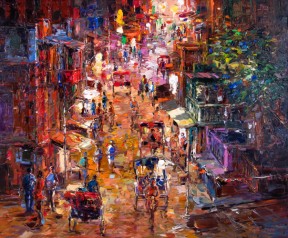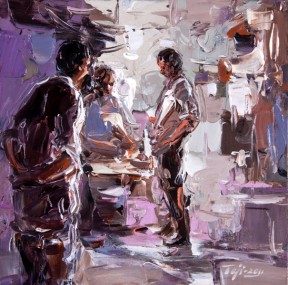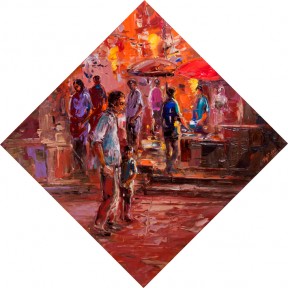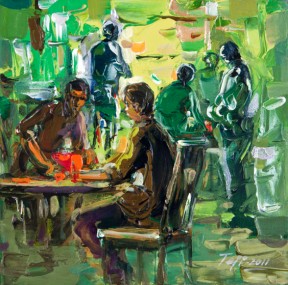It is said that every artist dips the brush in his or her own soul and paints the inner most self on canvas. Tejinder Kanda does the same as he digs into his recollection of a carefree childhood spent amidst green, open fields and fresh, clean air of rural Punjab. In a show titled Transmutation, he brings to life myriad landscapes of transmuted imagery – colourful and misty rain-washed by-lanes, cloudy skylines, the rustic simplicity of villagers, river banks and ghats, temples and worshippers, lush green creepers winding their way up the windows, flowers in full bloom, distant woods and hill tops – which shifts focus from one place or frame to another as memories metamorphose into impressionist renderings. The shadowy figures merge with the landscape, bringing them alive in a dynamic interaction with each other.
Growing up in a remote area around Batala, the young Teji, as he is fondly called even today, found “the smell of the soil and the huge wooden doors that I could not reach as a little boy fascinating” and loved watching his sister paint and mother make utilitarian artefacts in papier-mâché that were then used at home or sold in the market place. Given his deftness in drawing even as a child, it was not surprising that he decided to join the college of art in Chandigarh and took to painting as a profession.
Shifting base to Delhi, the budding artist had to struggle and traverse through an art track that moved from nature and life studies followed by figuration and then experimentation in print making – primarily serigraphy and intaglio. “I took to teaching art as I had got married early and had to make a living,” smiles the artist. But one can’t keep away from the intoxicating pull of being an artist for long and Teji soon gave up teaching to pursue art full time.
Travelling through the length and breadth of Punjab, Himachal, Rajasthan and other parts of the country, he visited the cities of Amritsar and Batala, ancient caves of Ajanta and Ellora, temples of Badami and Sanchi, pilgrim cities of Vrindavan and Banaras, hill towns of Chamba and Nainital and the port cities of Mumbai and Kolkata, and all these varied sights, sounds and smells were to then find place in his work.
The impressionist style of painting with thick impasto work led by French and European masters in the beginning the 19th century has clearly influenced the artist’s work. An avid admirer of Claude Monet and John Constable, he has evolved his own distinct idiom though. Without any distinct borders, his forms and subjects play hide and seek with the background, like snapshots merging at one place then disappearing only to re-appear as their own shadows in another part of the imagery. Partly dreamy and partly representational, the compositions capture the artist’s perception of life and the world around us.
While there is an interesting mix of abstraction and realism created by an inter-play of light and shade, it’s the use of thick, visible brush strokes in bright colours set against a softer palette that is a hallmark of Tejinder’s large body of impressionist expressions. Whether these are ordinary scenes, an intimate event or a festive experience, the focus is on the ambience rather than details and specifics. The artist has mastered the art of applying different colours in quick succession that allows an intermingling of the palette. Reflections and shadows are carefully monitored in his use of impasto as well.
“I like to work and finish the canvas in a single sitting, painting everything at once,” he says. “There are no premeditated drawings. It has to be all very spontaneous and immediate.”
However, the effect of his work – full of simple joys and elegant beauty – lingers on for a long time afterwards.
The show is on at Creativity Art Gallery, F-213 A, Lado Sarai, New Delhi till October 30.
Poonam Goel is a freelance journalist and has covered the arts for over 15 years. She contributes on visual arts for various newspapers, magazines and online media. More about her on Story Wallahs. Write to her @ poonamgoel2410@gmail.com










liked the paintings and the article both.